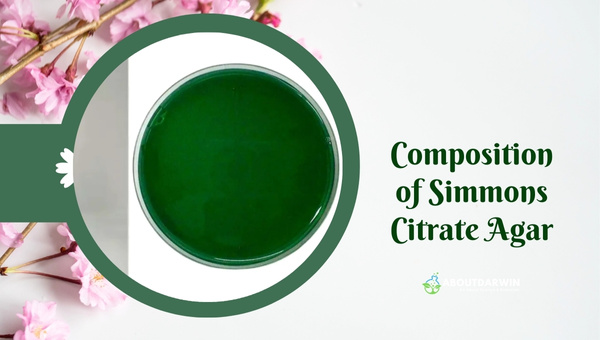Physical Address
304 North Cardinal St.
Dorchester Center, MA 02124
Gaining a robust understanding of Simmons Citrate Agar can be an incredible asset to someone studying or working in the field of microbiology. This particular type of medium offers a unique set of characteristics useful for identifying and differentiating various bacteria.
In this article, we’ll delve into what makes up Simmons Citrate Agar, how it works, and what it’s used for— everything you need to know, from its basic composition to interpreting results.
Simmons Citrate Agar is a differential medium that helps distinguish bacteria based on their ability to utilize citrate as their only source of carbon. It is a common tool used in laboratories that gives insights into the metabolic capabilities of different bacterial species.
Contents
The Simmons Citrate Agar is a notable entity in microbiology, made up of several integral components.

Without these constituents, some of the crucial microbiologic examinations wouldn’t be as effective.
Simmons Citrate Agar is primarily composed of particularly selected ingredients to provide the necessary conditions for bacterial growth and distinctive reactions. The essential constituents include:
Each ingredient plays its part and contributes significantly to realizing an optimal testing environment, which would otherwise not be achievable.
Each constituent within Simmons Citrate Agar plays its unique role, which collectively serves a broader purpose – facilitating bacterial growth and differentiation based on their metabolic properties.
By understanding each constituent’s function within Simmons Citrate Agar, we can comprehend why one would utilize this specific testing environment in laboratory settings.
Also Read: Unlock DNA Discoveries: Free DNA Upload Websites Guide
To fully appreciate what Simmons Citrate Agar brings to the table, we must look at its operating principle. In simple terms, the focus behind Simmons Citrate Agar revolves around the distinctive capabilities of different microorganisms.
Simply put, Simmons Citrate Agar operates by distinguishing microorganisms based on their capability to utilize citrate as their carbon source and ammonium dihydrogen phosphate as their nitrogen source.
The main component here is citrate, a derivative of citric acid that acts as a carbon source. For bacteria to thrive on this medium, they must possess the enzyme citrate, which manages to break down citrates into simpler substances for assimilation.
Another key ingredient is ammonium dihydrogen phosphate (NH4H2PO4), which serves as the sole nitrogen source in this medium. Certain bacteria can metabolize this component while others can’t.
When you introduce a bacterium sample into this environment where these are literally the only sources of ‘food,’ only microbes equipped with specific enzymatic capabilities manage to survive and multiply. That’s how it creates distinction among bacterial species.
Simmons Citrate Agar has an interesting reaction when interacting with different bacteria species:
This interactive performance helps scientists identify and differentiate certain bacterial strains—an essential feat not just for academic studies but also for practical purposes, such as diagnosing infections and finding the right treatments.
Hopefully, this explanation simplifies the rather complex principle that makes Simmons Citrate Agar such a critical tool in microbiology. Later, we’ll discuss how you can prepare it and interpret the results based on the color changes I’ve described above.
Also Read: Planning a Perfect Family Reunion: A Comprehensive Guide
After understanding the composition and principle behind the preparation of Simmons Citrate Agar, let’s delve into how it is actually used. From lab-based tests to real-world scenarios, this versatile microbial medium plays a significant role in bacteria identification and further research.
Simmons Citrate Agar is widely used in microbiology laboratories for various testing purposes. Let me detail a few scenarios to help illustrate:
Past the laboratory setting, Simmons Citrate Agar has several real-world applications too:
These diverse applications underscore and prove just how essential Simmons Citrate Agar is within and beyond laboratory scenarios. Whether you’re a researcher identifying novel bacterial species or a healthcare worker diagnosing infectious diseases, this growth medium plays a crucial role in our understanding and managing the microbial world.
Also Read: Sanborn Fire Insurance Maps: A Comprehensive Guide
When it comes to preparing Simmons Citrate Agar, the process might seem a little bit complicated at first. But don’t worry, I’m here to guide you through it—step by step.

In order to successfully prepare the agar, there are certain ingredients and steps we need to follow. Here’s a simple breakdown:
Seems simple, right? This stepwise guide can help you accurately prepare Simmons Citrate Agar, which can come in handy in various bacteriological tests. Just remember, precision is key when it comes to designing any microbial growth media.
Also Read: Isostatic Rebound: Uncovering Post-glacial Rebound Process
Yes, other selective media like Eosin Methylene Blue and MacConkey Agar can be used depending upon the type of bacteria you are testing.
While there are numerous methods for bacteria testing, the use of citrates in mediums like Simmons Citrate Agar ensures precise identification and differentiation of certain bacterial species.
Always wear gloves, lab coats and protective eyewear when working with “Simmons Citrate Agar”, as it may contain potential pathogens.
Typically, clear results can be seen within 24-48 hours of vaccination; however, it could vary depending on the bacterial strain.
No, Simmons’ Citrate medium is selective for gram-negative bacteria that can utilize citrate as a sole carbon source.
Also Read: Mastering Polymerase Chain Reaction: Principle & Application
After a detailed exploration of Simmons Citrate Agar, its undeniable significance in the field of microbiology becomes apparent. From its unique composition specifically designed to support bacterial growth to its wide array of uses in laboratory research and real-world applications, it’s clear that this tool plays an instrumental role.
Besides the uses, the knowledge about thorough preparation steps and interpreting results are equally crucial. An understanding of Simmons Citrate Agar opens avenues for more accurate bacteriological tests and discoveries while also providing an insight into substitution options and necessary safety precautions.